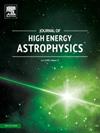Late-time constraints on dynamical dark energy models using DESI DR2, Type Ia supernova, and CC measurements
IF 10.5
4区 物理与天体物理
Q1 ASTRONOMY & ASTROPHYSICS
引用次数: 0
Abstract
The ΛCDM model has successfully explained various cosmological phenomena, yet persistent discrepancies in the measured value of the Hubble constant () known as the “Hubble Tension” challenge its completeness. Early Universe measurements from the cosmic microwave background (CMB) suggest km s−1 Mpc−1, whereas late-time measurements using the cosmic distance ladder yield km s−1 Mpc−1, resulting in a tension of 4σ to 5.7σ. To address this issue, researchers have proposed a range of alternative cosmological models in recent years. These models are based on dynamic dark energy scenarios featuring various parameterization schemes of the equation of state . In this study, we investigate some well-known dark energy models employing both two-parameter and three-parameter parameterizations of the equation of state . Using observational data from Cosmic Chronometers, Type Ia Supernovae, and Baryon Acoustic Oscillations (BAO) including the latest release from the Dark Energy Spectroscopic Instrument (DESI) Data Release 2 (DR2), we constrain key cosmological parameters such as the Hubble constant and the sound horizon at the baryon drag epoch . We explore these parameterizations and their impact on the expansion history of the Universe, with particular emphasis on the late-time cosmic evolution. Our analysis employs Markov Chain Monte Carlo simulations and several statistical tests to estimate parameter values, evaluate model performance, and assess deviations from the ΛCDM model.
利用DESI DR2、Ia型超新星和CC测量对动态暗能量模型的晚时间约束
ΛCDM模型已经成功地解释了各种宇宙现象,然而哈勃常数(H0)测量值的持续差异(被称为“哈勃张力”)挑战了它的完整性。来自宇宙微波背景(CMB)的早期宇宙测量结果表明,H0=67.4±0.5 km s−1 Mpc−1,而使用宇宙距离阶梯的后期测量结果表明,H0=73.04±1.04 km s−1 Mpc−1,导致张力为4σ至5.7σ。为了解决这个问题,研究人员近年来提出了一系列可供选择的宇宙学模型。这些模型基于动态暗能量场景,具有不同的状态方程参数化方案w(z)。在这项研究中,我们研究了一些众所周知的暗能量模型,这些模型采用了状态方程w(z)的两参数和三参数参数化。利用来自宇宙天文钟、Ia型超新星和重子声学振荡(BAO)的观测数据,包括暗能量光谱仪器(DESI)数据发布2 (DR2)的最新数据,我们约束了重子拖拽时期rd的关键宇宙学参数,如哈勃常数H0和声视界,我们探讨了这些参数化及其对宇宙膨胀历史的影响,特别强调了宇宙的晚期演化。我们的分析采用马尔可夫链蒙特卡罗模拟和几个统计测试来估计参数值,评估模型性能,并评估与ΛCDM模型的偏差。
本文章由计算机程序翻译,如有差异,请以英文原文为准。
求助全文
约1分钟内获得全文
求助全文
来源期刊

Journal of High Energy Astrophysics
Earth and Planetary Sciences-Space and Planetary Science
CiteScore
9.70
自引率
5.30%
发文量
38
审稿时长
65 days
期刊介绍:
The journal welcomes manuscripts on theoretical models, simulations, and observations of highly energetic astrophysical objects both in our Galaxy and beyond. Among those, black holes at all scales, neutron stars, pulsars and their nebula, binaries, novae and supernovae, their remnants, active galaxies, and clusters are just a few examples. The journal will consider research across the whole electromagnetic spectrum, as well as research using various messengers, such as gravitational waves or neutrinos. Effects of high-energy phenomena on cosmology and star-formation, results from dedicated surveys expanding the knowledge of extreme environments, and astrophysical implications of dark matter are also welcomed topics.
 求助内容:
求助内容: 应助结果提醒方式:
应助结果提醒方式:


